Abstract
THREE PROPOSED LATE IRON- AND VIKING-AGE MORTUARY HOUSES were recently excavated in Central Norway. Excavations and geoarchaeological investigations imply underground wooden buildings resembling domestic houses with doors. Radiocarbon dating indicates three succeeding buildings dating c AD 500–950. The finds included animal and food sacrifices. With their funerary context, the buildings provided an opportunity to frequently visit and interact with mortuary remains, as part of the rituals practised at cemeteries. They provided a ritualised space between the living and their dead relations.
Résumé
Rituels pratiqués dans les cimetières de la fin de l’Âge de Fer et de l’Âge Viking en Norvège : les maisons mortuaires de Skeiet, Vinjeøra par Raymond Sauvage et Richard I Macphail
Trois maisons mortuaires attribuées à la fin de l’Âge de Fer et à l’Âge Viking ont récemment fait l’objet de fouilles au centre de la Norvège. Les fouilles et investigations géoarchéologiques permettent de déduire qu’il s’agissait de bâtiments en bois ressemblant à des habitations domestiques avec des portes. La datation radiocarbone indique trois bâtiments successifs datés d’environ 500 à 950. Parmi les vestiges, on a retrouvé des sacrifices d’animaux et des victuailles. Avec leur contexte funéraire, ces bâtiments offraient une opportunité de rendre fréquemment visite aux dépouilles mortuaires et d’interagir avec, dans le cadre de rituels pratiqués dans les cimetières. C’était un espace ritualisé entre les vivants et leurs proches défunts.
Zussamenfassung
Rituelle Praktiken auf Friedhöfen der späten Eisenzeit und der Wikingerzeit in Norwegen: Die Totenhäuser aus Skeiet, Vinjeøra von Raymond Sauvage und Richard I Macphail
Vor kurzem wurden in Mittelnorwegen drei mögliche Totenhäuser aus der späten Eisen- und Wikingerzeit ausgegraben. Ausgrabungen und geoarchäologische Untersuchungen deuten auf unterirdische Holzbauten hin, die Wohnhäusern mit Türen ähneln. Radiokarbondatierungen lassen auf drei aufeinanderfolgende Gebäude aus der Zeit um 500–950 n. Chr. schließen. Zu den Funden gehören Tier- und Speiseopfer. Durch den Bestattungskontext der Gebäude bestand die Möglichkeit, die sterblichen Überreste häufig zu besuchen und mit ihnen zu interagieren, was Teil der auf Friedhöfen praktizierten Rituale war. Sie boten somit einen ritualisierten Raum zwischen den Lebenden und ihren verstorbenen Verwandten.
Riassunto
Pratiche rituali nei cimiteri della tarda età del ferro e dell’epoca vichinga in Norvegia: le case mortuarie di Skeiet, Vinjeøra di Raymond Sauvage e Richard I Macphail
Scavi recenti nella Norvegia centrale hanno portato alla luce tre case mortuarie attribuibili alla tarda età del ferro e all’epoca vichinga. Gli scavi e le ricerche geoarcheologiche portano a identificare edifici in legno simili a case di abitazione con porte. La datazione con il metodo del radiocarbonio indica che si tratta di tre costruzioni successive risalenti al 500-950 d.C. circa. I reperti comprendevano sacrifici di animali e di cibi. Nel loro contesto funerario gli edifici permettevano di fare visite frequenti e di interagire con i resti mortali come parte dei riti praticati nei cimiteri. Fornivano uno spazio ritualizzato tra i vivi e i parenti defunti.
Mortuary and funerary houses have existed in a wide range of periods and places. Examples are Neolithic Northern Europe, Ancient Egypt, the Iron-Age Baltic, and Viking-Age Scandinavia. We can recognise them as house-like structures found in funerary contexts; some contained tombs and furnished graves or functioned as depositories for the bones of cremated or excarnated ancestors, while others might have been used as shrines and places of worship and offerings related to the dead. In the Nordic late Iron Age (AD 575/600–1050) and particularly the Viking Age (AD 800–1050), several mortuary features may represent similar structures. One example is the wooden chamber graves from 5th‐ to 8th‐century Western Europe. They are found later in Scandinavia; with the best-known examples from Sweden and Denmark near the early towns of Birka and Hedeby. Both pre-dating and contemporaneous, comparable chamber graves are also recorded in the Baltic and within the medieval Rus territory in today’s Russia and Ukraine (Gräslund Citation1981; Eisenschmidt Citation1994; Mikhailov Citation2011). A parallel may also exist in the wooden house- or tent–like chambers in the grave ships of Oseberg and Gokstad, Norway (Gansum Citation2004; Price Citation2008). However, the features most often mentioned in literature as Scandinavian mortuary houses, are special buildings discovered at cemeteries in Denmark, Sweden, and Norway (Gardeła Citation2016, 188). One type consists solely of four-post constructions, which may sometimes surround a dug inhumation, like a late Viking-Age grave from Langeid, Southern Norway (Glørstad Citation2020). Other more substantial constructions consist of wall trenches, entrances, and post holes, which seem to represent free-standing buildings. Recently discussed finds of this type are from a late Iron-Age cemetery at Gulli in Southern Norway, and a longhouse-like building with mortuary finds from a Viking-Age cemetery in Sannagård at the Swedish western coast (Artelius Citation2000; Gjerpe Citation2005; Eriksen Citation2019, 192). In Norway, both types are unusual occurrences, but a few scattered examples are found; particularly from the southern and western regions and may be set both inside gravemounds and free-standing (Myhre Citation1976; Magnussen 2013; Glørstad Citation2020). A common theme for these constructions at cemeteries, is that they were spaces the living could enter, display, and interact with the dead, both literally and figuratively (Eriksen Citation2019, 191). By reflecting houses, they may also imply a continued existence of the dead inside gravemounds, as attested in later Icelandic saga literature (Price Citation2002, 134; Gardeła Citation2016, 174). In any case, they evoke the image of an active use and interaction between the living and the dead performed at Viking-Age cemeteries. Such interactions may be viewed as a way of worshiping the dead as part of ritual practice performed at cemeteries, corroborating previous hypotheses that ancestorial worship played a role (Birkeli Citation1943; Gräslund Citation2001; Gardeła Citation2016; Murphy Citation2018; Østigård and Kaliff Citation2020). Mortuary houses may be one of the features left on these sites where we see the notion of relating and interacting with dead ancestors most clearly.
Excavations in 2019 and 2020 of a pre-Christian cemetery from the late Iron-Age at Skeiet in Vinjeøra, central Norway (), revealed three probable mortuary houses evident as wall trenches set within ring-ditch enclosed burial mounds. While no burials survived within (an observation to be discussed below), the discovery indicates a continuing presence of three successive underground house-like buildings at the cemetery, from AD 575/600 to the end of pagan burials in the mid-900s. Two houses contained evidence of an entrance, demonstrated by trampled soil entrance-ways and support for a doorway. Vestigial finds of poorly preserved horse bones may provide clues to the actions that were undertaken within. With their clear mortuary setting, the buildings provided a space for interacting with the dead by enabling visits and access and evoke a strong link between the living and the dead. By discussing the function of the mortuary houses from Skeiet, this paper aims to broaden our understanding of the rituals practised at late Iron- and Viking-Age cemeteries.
The discovery of a Viking -age cemetery with mortuary houses at Skeiet
Flattened gravemounds under the fields on the farm of Skeiet in Vinjeøra were first discovered in 1996. Test trenching prior to planned road construction uncovered several parts of flattened, ditch- (ring ditch) enclosed gravemounds, indicative of a pre-Christian cemetery. Additionally, a Viking-Age grave containing weapons was found close to the ring ditches, which confirmed that the features were remains of gravemounds and graves, dating to the late Iron Age.
In 2019 and 2020, an extensive excavation was undertaken by the NTNU University Museum at the Norwegian University of Science and Technology, before the planned road construction. The entire area (11,000 sq m) was uncovered using mechanical topsoil stripping, and was shown to contain 11 circular and oval ring ditches covering an area of approximately 4,000 sq m. A nearby settlement with post-constructed buildings was also investigated and considered contemporary with and related to the cemetery ().
Fig 2 Aerial view overlooking the cemetery (foreground) during excavation in 2019 and the village of vinjeøra beyond, looking South-west. Photograph by Raymond Sauvage, © NTNU University Museum.
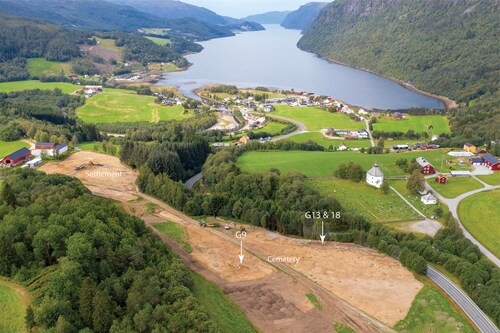
By employing large-scale topsoil stripping, the goal was to map the entirety of the spatial layout of the cemetery. Using single context documentation and extensive 14 C-sampling, we set out to map the chronological development of the cemetery. A broad range of burials (18 in total) was excavated: cremations, inhumations, and boat graves (). Two of the more intriguing finds were a pair of superimposed boat burials, and the suggested mortuary houses, which received considerable media attention (eg Best Citation2019; Hansen Citation2019). Initial analysis suggests that funerary activity started with cremations c AD 5757/600, with a transition to inhumations and introduction of boat graves AD 750–800 (). The last burials seem to have occurred c AD 950 (Sauvage and Lorentzen, forthcoming).
Fig 3 Plan of the cemetery excavated at Skeiet in 2019 and 2020. Illustration by Kristoffer Rantala, © NTNU University Museum.
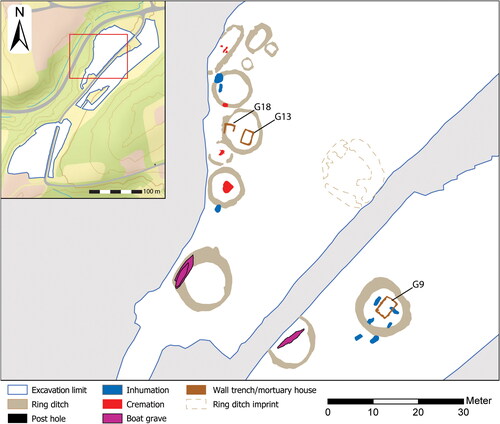
Geoarchaeological sampling (for soil micromorphology) was undertaken on buried soils and deposits in the funerary features. Samples from the mortuary houses consisted of three thin sections: one from a suggested trampled entrance layer, and two from wall trenches ( and 9c). The composition of the deposits suggests that the features should be understood as wooden-walled and roofed houses, probably accessed by a doorway (Macphail, Citation2021).
Fig 4 Plan of the mortuary houses and sample locations. The Tra-numbers refer to the radiocarbon date samples (see for details). Illustration by Kristofer Rantala and Raymond Sauvage, © NTNU University Museum.

The discovery of the mortuary houses provides an exceptional glimpse into complex burial- and mortuary practice in the Viking Age. The graves also contained a large corpus of gravegoods and biological remains, which is still being processed with publication planned for 2024, including a discussion on the chronological distribution of the burial practice (Sauvage, forthcoming).
Mortuary house construction
The mortuary houses show a clear consistency in layout, orientation, and shape. While the smallest building was only partially preserved due to later activity (, G18 and 5a), we could determine that the remains consisted of 0.2 − 0.3 m deep wall trenches enclosing rectangular interior space. The enclosed spaces were 2.4 × 2.5 m (G18), 3.3 × 2.3 m (G13) and 4.2 × 2.6 m (G9). G9 and G13 were within circular ring ditches, indicating that they were covered by a mound, while G18 had no clear indication of a related mound and was discovered under the ring ditch belonging to G13 (). Excavation revealed standing stones placed along the outer edge of the wall trenches in both G13 and G9 (), which may have supported a wooden structure of split logs or planking. Traces of supports for corner posts or staves remained in the four corners of the two larger buildings (, a).
Fig 5 Excavation photographs.
(a) Remnants of the U-shaped wall trench belonging to G18 mortuary house (photograph taken 2020). (b) G13 mortuary house with emptied wall trench and entrance (aerial photograph from 2019). (b) G9 mortuary house within ring ditch (aerial photograph from 2020). Photographs by Ole Husby (a) Kristoffer R. Rantala (b) and Raymond Sauvage (c), © NTNU University Museum.
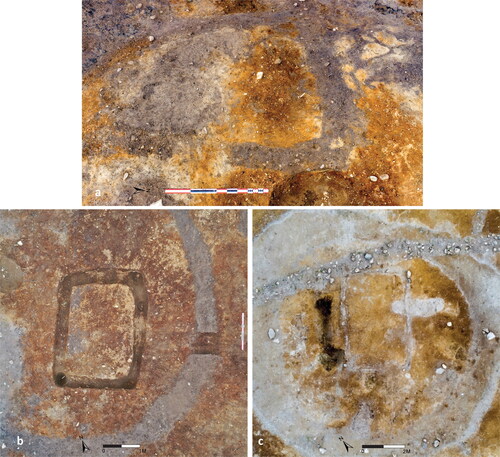
Fig 6 Photograph of the excavated wall trench from the G9 mortuary house displaying raised stone supports.
Photograph by Eystein Østmoe, © NTNU University Museum.
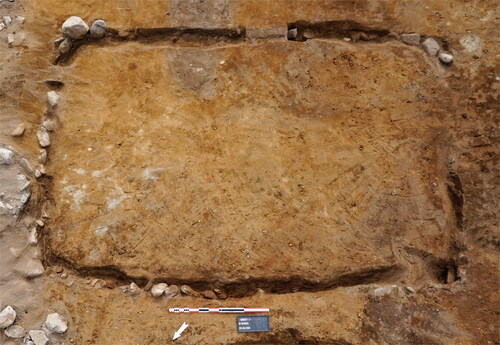
Evidence of wooden walls was also apparent in the soil micromorphology samples. The fine soil in the wall ditch had many very fine charcoal and amorphous organic inclusions—conceivably humified and pelletised wood fragments and coarse mineral materials (). Previously, such pelletised wood has been found in association with house floors, coffins and boat remains (Macphail and Goldberg, Citation2018, 479–84). This suggests fine organic sedimentation from the decomposing supposed wooden wall, at the same time as sands and gravels were ‘silting’ in from the sides of the wall trench. Possibly this all happened relatively rapidly, theoretically implying rapid decay of the ‘wooden’ structure (especially at the base of the wooden wall?).
Wooden walls were also suggested by a charred pine plank in the wall trench belonging to G13 (). There was no other evidence to suggest that the building had burned down, making the charred fragment of planking incongruous. However, the state of the fragment may derive from a known practice of pre-treating wood by charring, which may delay rotting in any subterranean elements such as the buried part of a wall or a post (Jensenius Citation2010, 158). This practice may also be attested by the charred appearance of one of the corner-post holes in G9 ().
Fig 7 Excavation photographs.
(a) Charred posthole in the south-western corner of the G9-wall trench. (b) Charred plank in the excavated G13-wall trench. Photographs by Eystein Østmoe (a) and Ole Husby (b), © NTNU University Museum.
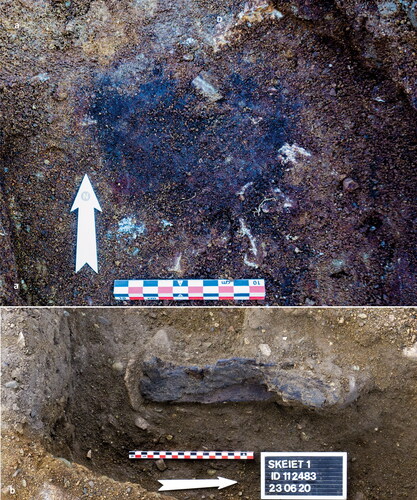
Thus, the mortuary houses appear to have been of wooden stave construction with earthfast corner posts and outer walls supported by raised stones in trenches. They are comparable with single-aisled corner stave buildings known across Northern Europe (eg Hauglid Citation1989; Jensenius Citation2010). This style is most famously recognised in the medieval Scandinavian stave churches, but its principles are also attested in domestic buildings such as dwellings and outhouses, as well as early ecclesiastical wooden buildings with earth-dug corner posts, at least from the early 10th century AD (Jensenius Citation2010; Sauvage and Mokkelbost Citation2016). Since both the walls and the corner posts were earthfast, it may be defined as a palisade building with corner posts (cf Almvik and Westin Citation2017, fig 19). The smallest building (G18) was different. No evidence of corner posts was found in it, which may indicate a building made of contiguous earthfast timbers without corner posts, similar to some of the earliest wooden churches in Sweden, Denmark and England (Gardiner Citation2021).
Mortuary house entrances
Access to the buildings was made possible by doorways, seen at G9 and G13. At these houses, were found the visible remains of possible entrances. In the first case (G9) it was apparent as an area of disturbed and mixed sand in the south-western gable (), which superimposed and blended with the wall ditch. In the other case (G13), it was visible as a darker trampled soil surface at the south-eastern long-side wall trench, blending into the associated ring ditch, almost like a small pathway (). In the same area, a single posthole in the wall trench evidenced a support for an opening or doorway in the building structure.
The geoarchaeological study made for a better understanding of the composition and depositional processes behind the trampled surface leading into the entranceway at G13. The sample is characterised by occasional fine charcoal and possible burnt sands and gravel—fine size charcoal and compaction being consistent with trampling; fissuring is also common in ‘beaten floor’ deposits, especially when not open to the weather, as found at ethnoarchaeological experiments () (Gé et al Citation1993; Macphail et al Citation2004; Rentzel et al Citation2017; Macphail and Goldberg Citation2018, Table 10.1, 368–79). It can therefore be suggested that this was a ‘roofed’ entrance way into the mortuary house.
Fig 8 Photomicrographs of the micromorphology samples.
(a) Micromorphology sample from G9: compact lower fill is composed of reddish-brown inclusions which could be woody residues. Plane polarised light (PPL), frame width is ∼0.90 mm. (b) High magnification image of A, showing oxidised, humified and pelletised remains of probable wood (of wooden walled mortuary house origin). PPL, frame width is ∼0.47 mm. (c) Micromorphology sample from putative entrance way to G13; compact trampled entrance way soil over original podzol subsoil (Bs–Bs horizon), with typical horizontal fissures and horizontal stones, as well as enigmatic vertically oriented larger stones. Frame width is ∼75 mm.
Photographs by Richard Macphail, © UCL.
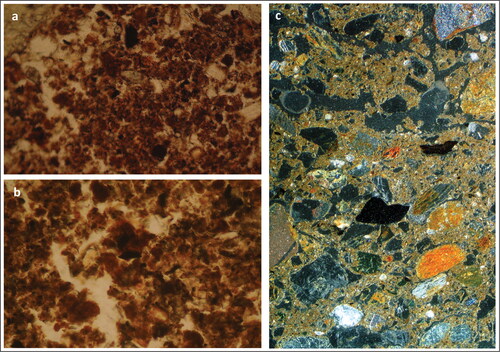
Fig 9 Excavation Photographs with traces of entrances.
(a) Disturbeded trampled soil over the S wall trench in G9. (b) Aerial photograph showing the outline of the G13 mortuary house and the trampled soil surface leading from the ring ditch into the wall trench. Sectioned area indicated with the arrows. (c) The section through the trampled soil surface in G9. The black box indicates the location of the micromorphology sample. Photographs by Eystein Østmoe (a), Kristoffer Rantala (b), and Ole Husby (c), © NTNU University Museum.
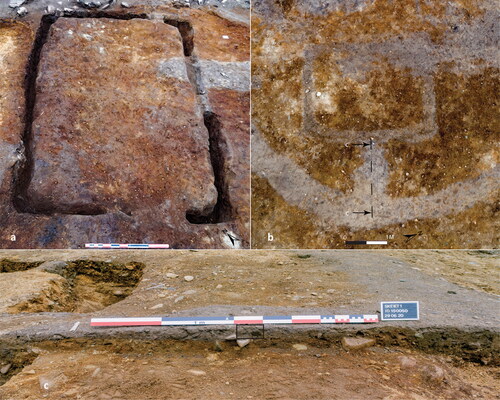
Table 1 Identified and unidentified osteological remains from the wall trenches of G9 and G13. Data from Kjellstöm et al. (Citation2021).
The entrances at the mortuary houses thus seem to resemble doorways as one would expect in a normal wooden building. The surfaces going into the doorways seem to be considerably trampled, suggesting more than just occasional usage, and speak of active use of the doorways and the buildings. The living could literally enter the gravemound to interact with its content.
Mortuary house Interior Functions
The small number of finds and lack of an associated grave at the mortuary houses, contrasts heavily with the richly furnished graves recorded elsewhere in the cemetery. This may be a preservation bias, considering that the original floor levels were lost due to later levelling. Other graves, being typically subterranean, were less affected. However, the fact that the entrances contained disturbed and trampled soil due to usage, may suggest that the recovered ground level was not far from the original. Thus, some evidence of a related burial (if present) would be expected to survive. Also, no evidence of a disturbed grave was present in the plough-soil and secondary layers that superimposed the buildings (as seen, for example, in a recent Danish find of an equestrian grave inside a similar house-like chamber from Fregeslev, Denmark) (Bagge Citation2020). This led us to suspect that a permanent grave was not present.
However, a limited amount of finds and osteological material were recovered from the wall trenches, which may shed light on related activity. The artefacts consisted of arrowheads and iron nails (), recovered while excavating the fill from the trenches. These artefacts were quite fragmented and were difficult to date using typology. Also, a limited amount of burned osteological remains was recovered from G9 and G13 () (Kjelstrøm et al 2021). Interestingly, no human remains could be identified. Some of the mammal bones may in theory have human origin; however, it is interesting to remark that the only identifiable species were horse and bones from mammals that could be of similar stature.
Fig 10 Ferrous finds from the wall trenches.
(A) T28278:1, arrowhead from G13. (B) T28278:2, nail from G13. (C) T28476: 2, arrowhead from G18. (D) T28274: 1, probable iron nail from G9. Photograph by Stian Ingdahl, © NTNU University Museum.
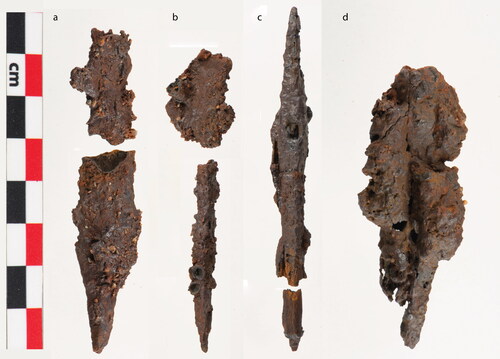
Presence of horse bones may imply that killing horses and the preparation of a ritual meal were associated with the function of mortuary houses. The sacrificial ritual known as blót was a central act in Norse religious practice, where killing and consuming flesh from animals was an important factor (Bray Citation2004). Being the second most frequent mentioned animal in ritual contexts in both contemporary and later written sources of old Norse religion, it is often assumed that horses were an important ritual animal (cattle has a slightly higher incidence) (Magnell Citation2019, 305–6). While archaeological finds imply other animals could be almost as important, the larger mammals seem to particularly relate to communal feasts and ritual practises such as burials (Magnell Citation2019, 315). Prevalence of horse remains and frequent presence of bridles and harnesses in graves, demonstrate the importance of horses and the ritual killing of horses in Norse burial traditions, particularly in Norway and Iceland (Leifsson Citation2018). Presence of horse bones might therefore relate to sacrificial practises associated with ritual functions of mortuary houses. However, it may be problematic to conclude that their presence indicates a practise of ‘sacrifice’, which can involve the slaughter of something (eg the animal) and an offering to a god (or an ancestor) who, hopefully, reciprocates, thereby establishing and nurturing the relationship between the giver and receiver (Insoll Citation2011, 151–2). Defining and identifying this relationship from the archaeological evidence is often problematic (Gräslund Citation2001; 224). However, considering that all animal bones from the wall trenches at Skeiet were burned, it might suggest the cooking and preparation for consumption. Considering the mortuary houses’ strong association with the dead, the bones could imply ritual meals in close connection with burials and the dead, although whether this should be considered a sacrifice is unclear. A comparable interpretation has been suggested for similar remains in the wall trench of the mortuary house at Gulli in Southern Norway, as well as other finds of animal bones in mortuary contexts (Gräslund Citation2001, Gardeła Citation2016; 196). It is likely that the fragments from G9 derived from such rituals, where small fragments lost on the floor, and moved to the wooden palisade wall by trampling, finally ‘trickling’ into the wall trench. G9 was set in an area of the cemetery with no previous cremations (), thus ‘pollution’ from earlier activity seems unlikely.
Mortuary house Chronology
In the absence of closely datable artefacts and a continuing stratigraphic sequence, we relied on AMS radiocarbon dates from material from the wall trenches (). To evaluate possible start- and end points for the construction of each building (posteriors), a simple Bayesian model was calculated using OxCal V.4.4.4, following the structure recommended by Bronk Ramsey (Citation2009) and using the IntCal20 calibration curve (Reimer et al Citation2020). Dating mixed contexts such as wall trenches may be challenging, considering the lack of a clear closed relationship between the archaeological feature and the dated material (particularly when no stratigraphical relationship is established) (Herschend Citation2016). The evaluated dates therefore also include samples from stratigraphic related features, and the model () includes dates from features that were stratigraphically earlier and later than the wall trenches as constraints. Also, the G9 wall trench samples were double measured using two separate pieces of charcoal from the same sample, and an average determined ().
Fig 11 Oxcal calibration plot with the bayesian modell of the 14 C-dates from the mortuary houses, and the related features used as constrains (oxcal v 4.4 Bronk Ramsey Citation2021; atmospheric data from Reimer et al Citation2020). Information on the sampled material for each date is available in . The two outliers (in red) are not included in the calculation of the result.
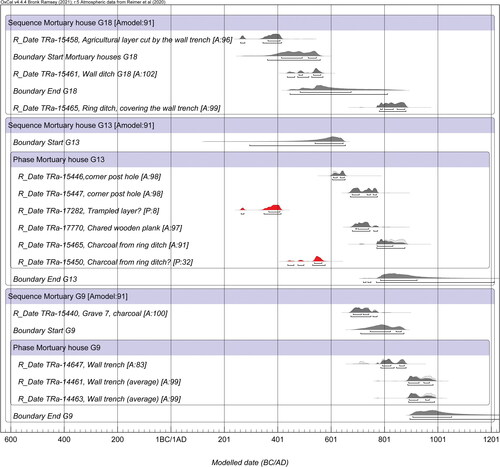
Table 2 List of 14 C dates from the mortuary sites and stratigraphically relevant features. Tra14461 and Tra-14463 are calculated as an average of two measurements from each sample (in italics). Outliers (in bold) is not included in the model ().
Overall, the dates and the calculated model indicate a three-step chronological timeline for the mortuary houses. The first house (G18) was probably built sometime between AD 450–600, the next (G13) between c AD 600–800, and the final c AD 800–to the mid or late 900s (). It was not possible to estimate the lifetime and durability of each house, but based on the distribution of dates, we would suggest each building was used for 100–200 years.
DISCUSSION
The results demonstrate that mortuary houses were a central component on the cemetery from the very start, and were replaced in two stages, underlining a need for continuity in the buildings. Based on the dates, we suggest a life span of each building of c. 100–200 years, before being replaced. Durability of buried wooden features depends on many elements, such as the type of timber, treatment, and local soils (Webley Citation2008). Being covered by mounds, we should at least expect that structural problems would arise after a century. The geoarchaeological evidence also point to a (fairly) rapid decomposition of the buried element of the lower walls (see above). This does not however necessarily compromise the entire stability of the structure (Reynolds Citation1995). We do not know if they were covered from the start, or if they were left free-standing for a while before being covered. In any case we suggest that the chronology illustrates a continuing need for this type of feature at the cemetery throughout its life, indicating that their use was an integrated part of performed routines and practises at the cemetery.
Other putative mortuary houses are of varied construction, some consisting of only a four-post frame or supports for a simple roof or canopy (Gardeła Citation2016, 188). In contrast, Skeiet attests to more substantial house-like constructions (). This relates them to finds that rather resemble contemporary domestic buildings with entrances, such as the small three-aisled longhouse with mortuary evidence at Sannagård in Southern Sweden, and the small building with postholes and a U-shaped wall trench at Gulli in Vestfold in Southern Norway, both interpreted as mortuary houses (Artelius Citation2000, 147; Gjerpe Citation2005, Eriksen Citation2019, 191). Thus, the mortuary houses from Skeiet may seem to echo contemporary buildings like the domestic dwellings which we recorded at the nearby settlement (Bryn, forthcoming). Accordingly, we can also see them as allusions to domestic houses, with doorways, walls, and roofs.
Fig 12 Artist’s interpretation of the G13 mortuary structure during use. The conjectured lines indicate the possible outline of the burial mound. Illustration by Arkikon, © NTNU University Museum.
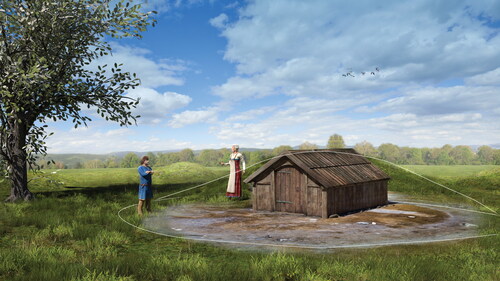
Since they were covered by earthen gravemounds, they also reflect a clear mortuary motif. Several examples of funerary contexts contemporary to the Skeiet mortuary houses are encountered in the Norse world which seem to echo similar domestic imagery. Examples are the tent-like wooden grave houses at the Oseberg and Gokstad ship graves, and the late Iron-Age wooden chamber graves, recorded in Western Europe and the Norse sphere of influence, especially in South Scandinavia, the Baltic, and within the Rus territory (Gräslund Citation1981; Eisenschmidt Citation1994; Mikhailov Citation2011). Later Icelandic saga accounts that reflect a notion of a continuing existence of the dead inside gravemounds, may be what is alluded to here (as indicated by the description of the mound burial of Freyr in Ynglinga saga and a grave intrusion described in Grettis Saga Ásmundarsonar) (Ynglinga Saga Ch 10; Grettis Saga Ásmundarsonar Ch 18; Price Citation2002, 134; Gardeła Citation2016, 174). Hence, the mortuary houses at Skeiet significantly enrich the known corpus of mortuary monuments that reflect houses and the domestic realm. The corner stave-method applied at Skeiet, was interestingly also characteristic for the construction and architectural principles of contemporary feasting halls, later reflected and transferred as the chosen construction for the early wooden churches (Gansum Citation2008). Therefore, we may also view the Skeiet mortuary houses as underground funerary reflections of halls, similar to the hogback stones used as grave markers in Anglo-Scandinavian Britain; the latter funerary objects were made in the image of halls and reflected imagery of houses for the dead (Lang Citation1984). It may be relevant to see such mortuary monuments as alluding to a belief in dead warriors’ continuing existence in the feasting hall, like in Valhalla as part of the Odin-cult (although it must be kept in mind that the literary sources on which Norse mythology rest significantly postdate the archaeological evidence).
It is however not clear if providing a dwelling for the dead (as a reflection of a domestic or eternal feasting-existence) is the main purpose of the mortuary houses. The results, which suggest entrances that were used actively, implied by the trampled entrance floor surfaces, tell us that the interior was visited repeatedly. It has previously been suggested that a purpose of mortuary houses was to display and interact with the dead (Eriksen Citation2015, 89; 2019, 191–3). The dry trampled floor indicates that visitations were quite frequent, perhaps showing they were performed not only during the actual burial, but also repeatedly throughout an active use of the cemetery as a ritual and performative space (eg Price Citation2010; Moen Citation2020). Since the dry trampled entrance-floor at G13 blended into the ring ditch, we may also suggest that the entrance had a protruding super-structure, perhaps making room for a portal or covered doorway into the mound, passed when entering.
Doors and portals could be highly ritualised, and the thresholds were especially important liminal spaces, where the living could contact the dead and the death realm as part of Viking-Age funerary practices. If we see mortuary houses as spaces where the living could enter and interact with the dead, the entrances may be seen as doors and portals for crossing the threshold between the world of the living and the world of the dead (as argued by Eriksen Citation2013, Citation2015, Citation2019). A parallel which illustrates similar motifs are the so-called south-western portals, rectangular stone cists with possible supports for a portal, placed at the edge of gravemounds in eastern Sweden. Presence of cooked animal bone remains in these structures has suggested they were used to offer or share food with the dead (Gräslund Citation1969, Citation2001). Adding to this, they have also been seen as ritualised portals or thresholds created at the edge between the dead and the living (Eriksen Citation2013, Citation2019, 203). Another example is the Gotlandic picture stones which were often placed at grave sites and whose shape is seen to replicate portals or doorways (Arrhenius Citation1970; Eriksen Citation2019). These examples indicate that the doors in the mortuary houses were not a unique mortuary expression but show that doors and portals could manifest in different ways in mortuary contexts. In any case the notion of providing a space and threshold between the living and the dead seems to have been an important aspect.
However, if passing the doorway and interacting with the dead was the prime purpose for visits, the lack of an internal grave at Skeiet may seem strange. What was kept inside? Since it is impossible to construct burial mounds and graves during the Norwegian winter, they may have functioned as temporary graves until burial was possible. This is of course a viable option which would leave similarly few archaeological remains.
It does not necessarily need to be (only) a functional reason to keep bodies accessible. A close connection between the living and remains of the dead seems to have been common, indicated by a wide practice of grave re-opening and interacting with human remains seen in contemporary cemeteries in both Western Europe and in the Norse world (Klevnäs Citation2016; Klevnäs et al Citation2021). Prolonged death rituals and burials are another occasion that may have provided the time and space for living-dead interaction. This is exemplified in the Oseberg ship grave, where studies of the original field data show that the grave chamber was only partially covered by a mound during the burial. The mound was finished only after considerable time had passed (Gansum Citation2004; Price Citation2008). Even though the longevity of the Oseberg burial has been questioned (Nordeide Citation2011), the effort of constructing the monumental burial mound and the elaborate burial rituals must have lasted long enough to allow for a period of visiting and interactions with the dead, before a final ‘burial’ of both ship and chamber. Similar actions may also be alluded to in Ibn Fadlan’s description of a possible elaborate Norse burial ritual in the Rus territory, where the body was placed in a temporary buried wooden chamber during the ten-day burial ritual, with food and gravegoods (possible a chamber grave or mortuary house?), before the climax of the burial ritual and the cremation (Montgomery Citation1970; Gardeła Citation2016, 191). If we transfer similar practice to Skeiet, bodies could have been kept temporarily in the mortuary houses until final burial or cremation elsewhere on site, not primarily as a functional response to frozen ground, but to allow for a liminal transition period between death and final burial. This would also allow time to lay out and wash the body, and to conduct essential rituals and preparation before burial or cremation. Interestingly, none of the chamber graves seen at Birka or at Hedeby in southern Denmark (Gräslund Citation1981; Eisenschmidt Citation1994; Bagge Citation2020), nor the eastern chamber burial in the Baltic and in the Rus territory (Mikhailov Citation2011), seem to have evidence of entrances. The same is true for the four-post constructions discovered at some Scandinavian cemeteries like at Langeid in southern Norway, which, like the chamber graves, included a permanent burial (Glørstad Citation2020). Thus, it may seem to be a difference in the notion between these features, where the chamber burials and the four-post constructions were perceived as a permanent residence for the dead, compared to the mortuary house where doors facilitated visiting and directly interacting with the remains. Hence, we can see the mortuary house as a vessel for symbolic transfer from biological death to social death (similar to arguments by Eriksen Citation2019, 189–90).
Finds of burnt animal bone, such as equine in the G9 wall trench, may suggest the offering of food to the dead and ritual meals, similar to observations made in other Scandinavian cemeteries for example the south-western portals in Sweden and in the mortuary house at Gulli (Norway) (Gräslund Citation2001; Gardeła Citation2016). Food offerings to the dead and conducting ritual meals at the graveside has historically occurred several places - a recent nearby example of a suggested long-lived tradition is from the Setomaa district in southeast Estonia (Valk Citation2006). Feasting with the dead is also recorded as part of preparation for burial (a wake with feasting and dancing) in pre-modern Norway, as well as a practise of offering food and drink at burial mounds which have been documented until the 19th‐century AD, both possibly a remnant of pre-Christian ancestor worship (Birkeli Citation1943, 25, 45). If dead bodies were temporarily kept inside the buried mortuary houses, the doorways and indicated food offerings may indicate that similar offerings and rituals could take place in a designated building inside the burial mound, perhaps in the form of sharing ritual meals with the dead, during the transitional period between biological and social death.
Late Iron-Age, and particularly Viking Age burials display significant diversity in burial practices and may be influenced by such things as local traditions, beliefs, and social status (Price Citation2008, Williams Citation2016). As noted above, the actual burials detected at Skeiet represent burial practices that changed throughout the late Iron Age, with a transition from cremations to inhumations and an introduction of inhumations and boat burials c AD 700–800 (as discussed above, , see also Sauvage et al forthcoming). The chronological distribution of the mortuary houses, however, reveals they were a continuing presence at the cemetery for four centuries. Thus, the mortuary houses provide an example of long-time continuity in practised mortuary rituals, providing a contrast to the heterogenous and changing burial practises seen in the graves. Therefore, understanding the role of late Iron-Age mortuary houses may be a good foundation to discuss the nature of long-term funerary practices carried out by each farm at their cemeteries. Cemeteries had many roles and functions in society, one of them being an arena for the practice of worshiping the dead (Gardeła Citation2016). Considerable parts of pre-Christian Norse rituals took place as part of everyday life in the dwellings and farms where most people lived their life, and at the cemeteries where their ancestors were buried. Ancestors marked by their gravemounds also legitimised property rights. Important ancestors may have been worshiped and treated with revered status in their family lineages, whether ancestors of kings and queens, or the original founder of the family farm (Birkeli Citation1943; Gardeła Citation2016; Zachrisson Citation2017; Murphy Citation2018) The investigations at Skeiet reveal that the mortuary houses were a continuous presence at the cemetery until the end of pagan burials, and as spaces for handling, displaying, and interacting with the dead, they enabled visits and access and evoked a strong link between the living and the dead. By echoing dwellings and possible halls, they may also have signified belief in a continuing existence of deceased ancestors in the burial mounds.
One of the new contributions is the doorways and the possible portals that allowed frequent access, which may have constituted a ritualised threshold between the land of the living and the dead (as argued by Eriksen Citation2019, 200–5, see above). If related to ancestorial rituals, this may have allowed communication with deceased close kin and ancestors. Food offerings, and perhaps feasting with the dead, may also be recorded, and probably associated with the use of the buildings. In the pre-Christian world, where religion, death, and daily life were highly interwoven elements, an intimate relationship with the dead was probably perceived as a natural part of the associations between the family and the ancestors.
CONCLUSION
By examining construction, entrances, and traces of related activity in the mortuary houses from Vinjeøra, it was possible to identify important aspects of their function as funerary features and their role in burial rituals in the period AD 550–950. While the construction of these features shares commonalities with contemporary house-like and building-like mortuary structures, the existence of entrances, backed by geoarchaeological findings, suggests that these spaces were actively utilised. This suggested activity that is not recognised in other grave features, such as chamber graves. The study suggests that these entrances served as doors and portals into burial mounds, which functioned as a threshold between the world of the living and the world of the dead, that may have facilitated ritual communication with deceased close kin and ancestors. The entrances may have featured super-structures or covered doorways, further emphasising their ritual significance. In terms of the interior, it appears they did not contain permanent graves, raising questions about what was kept inside these structures. It is suggested they served as temporary graves until final burial or cremation. The longevity of late Iron-Age mortuary rituals makes is apparent that this phase provided a period of visiting of and interacting with the dead, which suggests mortuary houses facilitated the body’s transfer from biological death to social death. The presence of burnt animal bones in wall trenches suggests the occurrence of ritual meals and food offerings to the dead during this phase. As a continuing presence at a cemetery with changing burial practices during its life, they are an example of stable funerary ritual activity which indicates continuing close and intimate connection between the living and the dead within the community, and underlines the importance of ancestors in mortuary rituals. This is clearly related to a widespread practice of interacting with mortuary remains as part of funerary rituals, such as secondary intrusions and grave manipulations. It may prove beneficial to study these phenomena as related expressions within the ritual practices performed at cemeteries.
Because of the fragmentary nature of the evidence, caused by ploughing and poor preservation conditions, this study provides only some insights into the function of the three buildings. This is particularly relevant to the missing floor levels, resulting in a lack of direct evidence of interior activities and structures. The same can be said for the proposed super-structure over the entrances, where only indirect construction elements remained. There is also a question of when the construction was covered by the burial mound. However, by focusing on a combination of archaeological observations, soil-micromorphology, finds, and radiocarbon dating, the interpretation of the features as mortuary houses and the suggested functions appears persuasive. To further understand the phenomena, future studies should focus on providing more detailed information on the interior, entrances, and the chronological relationship to the burial mound. This can be achieved by sampling floor levels (if present) for additional geoarchaeological information, identifying construction elements from the proposed entrance super-structure (such as post-holes), and determining stratigraphic information on the relationship between the mortuary house and the burial mound.
Acknowledgments
The authors would like to thank the field staff at the E39 Betna–Stomryra project, particularly Astrid Lorentzen, Kristofer Rantala, and Stian Ingdahl for discussions, graphic works, and photoraphs. We are also grateful to Professor James Barrett and to Dr Silje Fretheim for the encouragement and useful comments to this work, and to the two anonymous reviewers who provided valuable insights that helped improve the text. This work was funded by the Norwegian Public Roads Administration and the Norwegian University of Science and Technology (NTNU).
Disclosure statement
No potential conflict of interest was reported by the author(s).
BIBLIOGRAPHY
- Almvik, G and Westin, J 2017, ‘Hemse stave church revisited’, Lund Archaeological Review, 23, 7–25.
- Arrhenius, B 1970, ‘Tür der Toten Sach‐ und Wortzeugnisse zu einer frühmittelalterlichen Gräbersitte in Schweden’, Frühmittelalterliche Studien, 4, 384–94.
- Artelius, T 2000, Bortglömda föreställningar: begravningsritual och begravningsplats i halländsk yngre järnålder, Riksantikvarieämbetet arkeologiska undersökningar Skrifter 36, GOTARC, Series B, Gothenburg Archaeological Theses 15, Stockholm: Riksantikvarieämbetet.
- Bagge, M S 2020, ‘The extraordinary chamber grave from Fregerselv, Denmark: The find, excavation and future’, in A S Pedersen and S Sindbæk (eds), Viking Encounters: Proceedings of the Eighteenth Viking Congress, Denmark, August 6–12, 2017, Aarhus: Aarhus University Press, 505–15.
- Best, S 2019, ‘Unusual’ Viking boat grave contains bodies of 2 people who died 100 years apart’ Daily Mirror, <www.mirror.co.uk/science/unusual-viking-boat-grave-contains-20971359> [accessed 12 January 2023].
- Birkeli, E 1943, Fedrekult. Fra norsk folkeliv i hedens og kristen tid, Oslo: Dreyer.
- Bray, D 2004, ‘Sacrifice and sacrificial ideology in Old Norse religion’, in C Hartney and A McGarrity (eds), The Dark Side: Proceedings of the Seventh Australian and International Religion, Literature and the Arts Conference, 2002, Sydney: RLA Press, 125–35.
- Bronk Ramsey, C 2021, OxCal v.4.4.4, <https://c14.arch.ox.ac.uk/oxcal.html>
- Bronk Ramsey, C 2009, ‘Bayesian analysis of radiocarbon dates’, Radiocarbon, 51:1, 337–60.
- Bryn, H forthcoming, Building traditions and settlement organisation at Skeiet from the Migration Period to the Black Death, in R Sauvage (ed), From life to death in Iron Age and medieval Vinjefjord Unveiling burial practices, settlement and landscape history, Kristiansand: Nordic Open Access Scholarly Publishing.
- Eisenschmidt, S 1994, Kamnzergräber der Wikingerzeit in Altdänenzark, Bonn: Habelt.
- Eriksen, M H 2013, ‘The power of doorways and thresholds in Viking Age Scandinavia’, Archaeological Dialogues, 20:2, 187–214.
- Eriksen, M H 2015, Portals to the past. An archaeology of doorways, dwellings, and ritual practice in late Iron Age Scandinavia (Unpubl PhD thesis, University of Oslo).
- Eriksen, M H 2019, Architecture, Society, and Ritual in Viking Age Scandinavia. Doors, Dwellings, and Domestic Space, Cambridge: Cambridge University Press.
- Gansum, T 2004, Hauger som Konstruksjoner—Arkeologiske Forventninger Gjennom 200 år, Göteborg: Göteborg University.
- Gansum, T 2008, ‘Hallene og stavkirkene — kultbygninger i en overgangstid’, in K Childis et al (eds), Facets of Archeology: Essays in Honour of Lotte Hedeager on Her 60th Birthday, Unipub and Institutt for arkeologi, konservering og historiske studier, Oslo: University of Oslo, 199–213.
- Gardeła, L 2016, ‘Worshiping the dead: Viking Age cemeteries as cult sites?’, in M Egeler (ed), Germanische Kultorte. Vergleichende, historische und rezeptionsgeschichtliche Zugänge, Münchener Nordistische Studien 24, Munich: Herbert Utz Verlag, 169–206.
- Gardiner, M 2021, ‘Twelfth‐century timbers from Sixhills, Lincolnshire, and a review of medieval stave construction in England’, Vernacular Architecture, 52:1, 30–40.
- Gé, T, Courty, M A, Matthews, W et al 1993, ‘Sedimentary formation processes of occupation surfaces’, in P Goldberg et al (eds), Formation Processes in Archaeological Contexts. Monographs in World Archaeology No 17, Wisconsin: Prehistory Press, Madison, 149–63.
- Gjerpe, L E 2005, ‘Uthus, kulthus, dødehus eller grav?', in L E Gjerpe (ed), Gravfeltet på Gulli. E18–Prosjektet Vestfold, Bind 1, Varia 60, Oslo: Kulturhistorisk Museum Fornminneseksjonen, 147–51.
- Glørstad, Z T 2020, ‘The Cross and the Sword: Signs of dual religious belonging in a late Viking Age warrior grave at Langeid, South Norway’, in A Pedersen and S M Sindbæk (eds), Viking Encounters: Proceedings of the Eighteenth Viking Congress, Aarhus: Aarhus University Press, 198–207.
- Gräslund, A –S 1969, ‘Särdrag innom vikingatidens gravskick’, in H Christiansson and Å Hyenstrand (eds), Nordsvensk forntid (= Skytteanska Samfundets handlingar 6), Umeå: Umeå Universitet 133––50.
- Gräslund, A –S 1981, Birka 4: The Burial Customs a Study of the Graves on Björkö, Kungl. Vitterhets historie och antikvitets akademien, Stockholm: Almqvist and Wiksell International.
- Gräslund, A –S 2001, ‘Living with the dead. Reflections on food offerings on graves’, in O Sundqvist and A Van Nahl (eds), Kontinuitäten und Brüche in der Religionsgeschichte. Festschrift für Anders Hultgård zu seinem 65. Geburtstag am 23.12.2001, Berlin: Ergänzungsbände zum Reallexikon der germanischen Altertumskunde, 31, 222–35.
- Grettis Saga Ásmundarsonar, trans Fox, D and Pálsson, H, Foraldersögur Norðurlanda, Reykjavík: Bókaútgáfan Forni, 1943.
- Hansen, F K 2019, Viking Age mortuary house found in central Norway. Website: Science X (Phys.org), <phys.org/news/2019-09-viking-age-mortuary-house-central.html> [accessed 12 January 2023].
- Hauglid, R 1989, ‘Nordens eldste trekirker’, Fornvännen’, Journal of Swedish Antiquarian Research, 84, 51–6.
- Heimskringla, Y S 2002, History of the Kings of Norway, trans L M Hollander, Austin: University of Texas Press.
- Herschend, F 2016, ‘Towards a standardized discussion of priors in Bayesian analyses of 14C dated archaeological periods: A study based on the dates from Gjøsund’, Journal of Archaeology and Ancient History (JAAH) 19, 1–28.
- Insoll, T 2011, ‘Sacrifice’, in T Insoll (ed), The Oxford Handbook of the Archaeology of Ritual and Religion, Oxford: Oxford University Press, 151–65.
- Jensenius, J H 2010, ‘Bygningstekniske og arkeologiske bemerkninger og trekirker I Norge i vikingtid og middelalder’, Collegium Medievale, 23, 147–78.
- Kjellstöm, A, Storå, J and Gummesson, S 2021, Osteologisk analys av brända ben från Vinjeøra, E39 Betna ‐ Stormyra‐prosjektet. OFL Rapport, 2021:5. (Unpubl Rep: Osteoarchaeological Research Laboratory, University of Stockholm).
- Klevnäs, A M 2016, ‘Imbued with the essence of the owner’: personhood and possessions in the reopening and reworking of Viking-Age burials’, European Journal of Archaeology, 19:3, 456–76.
- Klevnäs, A M, Aspöck, E, Noterman, A A et al 2021, ‘Reopening graves in the early Middle Ages: from local practice to European phenomenon’, Antiquity, 95:382, 1005–26.
- Lang, J 1984, ‘The hogback. A Viking colonial monument’, in S C Hawkes et al (eds), Anglo–Saxon Studies in Archaeology and History, 3, Oxford: Oxford University Committee for Archaeology 83–176.
- Leifsson, R 2018, Ritual Animal Killing and Burial Customs in Viking Age Iceland (PhD thesis, The University of Iceland).
- Macphail, R I 2021, E39 Betna—Stormyra: Soil Micromorphology (Unpubl Rep for the NTNU: Institute of Archaeology, University College London).
- Macphail, R I and Goldberg, P 2018, Applied Soils and Micromorphology in Archaeology, Cambridge: Cambridge University Press.
- Macphail, R I, Cruise, G M, Allen, M J et al 2004, ‘Archaeological soil and pollen analysis of experimental floor deposits; with special reference to Butser Ancient Farm, Hampshire, UK’, J Archaeolog Sci , 31, 175–91.
- Magnell, O 2019, ‘Animals of sacrifice: Animals and the Blót in the Old Norse sources and ritual depositions of bones from archaeological sites’, in K R Wikström et al (eds), Myth, Materiality, and Lived Religion: In Merovingian and Viking Scandinavia, Stockholm: Stockholm University Press, 303–37.
- Magnussen, J P Den Gløymte gravskikk? Ein diskusjon til dødehusgravskikken i jernalderen (Unpublished MA thesis, The University of Tromsø).
- Mikhailov, K 2011, ‘Chamber–graves as an international burial custom of the Viking Age: from Old Denmark to Old Russia’, in M Rebkowski (ed), Wolińskie Spotkania Mediewistyczne I. Eksluzywne życie—dostojny pochówek w kręgu kultury elitarnej wieków średnich, Wolin: Institute of Archaeology and Ethnology, Polish Academy of Sciences, 205–21.
- Moen, M 2020, ‘Familiarity breeds remembrance: on the reiterative power of cemeteries’, World Archaeology, 52:1, 35–48.
- Montgomery, J E 1970, ‘Idn Fadlan and the Rusiyyah’, JAIS, 3, 1–25.
- Murphy, L J 2018, ‘Paganism at Home. Pre-Christian Private praxis and household. Religion in the Iron-Age North’, Scripta Islandica, 69, 49–97.
- Myhre, B 1976, ‘Hus over grav?’, Arkeo: arkeologiske meddelelser fra Historisk museum’, Universitetet i Bergen, 5, 14–18.
- Nordeide, S W 2011, ‘Death in Abundance—Quickly!’, Archaeology: North Atlantic to the Baltic on to the Mediterranean’, Acta Archaeologica, 82, 7–15.
- Østigård, T and Kaliff, A 2020, Likbrud og dødsbryllup. Sjelen, sykdommer og oldnordiske gravskikker, Occasional Papers in Archaeology 69, Uppsala: Uppsala Universitet.
- Price, N 2002, The Viking Way: Religion and War in Late Iron Age Scandinavia, Uppsala: Uppsala University Press.
- Price, N 2008, ‘Dying and the dead: Viking Age mortuary behaviour’, in S Brink and N Price (eds), The Viking World, London: Routledge, 257–73.
- Price, N 2010, ‘Passing into poetry: Viking‐Age mortuary drama and the origins of Norse ythology’, Medieval Archaeology, 54:1, 123–56.
- Reimer, P J, Austin, W E, Bard, E et al 2020, ‘The IntCal 20 Northern Hemisphere radiocarbon age calibration curve (0–55 cal kBP)’, Radiocarbon, 62:4, 725–57.
- Rentzel, P, Nicosia, C, Gebhardt, A et al 2017, ‘Trampling, poaching and the effects of traffic’, in C Nicosia and G Stoops (eds), Archaeological Soil and Sediment Micromorphology, Wiley Blackwell, Chichester, 281–98.
- Reynolds, P 1995, ‘The life and death of a post‐hole’, in E Shepherd (ed), Interpreting Stratigraphy 5, Proceedings of a Conference Held at Norwich Castle Museum on 16th June 1994 and Supported by the Norfolk Archaeological Unit, 21–5.
- Sauvage, R (ed) forthcoming, From Life to Death in Iron Age and Medieval Vinjefjord: Unveiling Burial Practices, Settlement, and Landscape History, Kristiansand: Cappelen Dam Akademisk/NOASP, Nordic Open Access Scholarly Publishing.
- Sauvage, R and Lorentzen, A forthcoming, ‘Late Iron Age and Viking Age local burial practices: The cemetery at Skeiet, Vinjeøra’ in R Sauvage (ed) (forthcoming), in R Sauvage (ed) (forthcoming), From Life to Death in Iron Age and Medieval Vinjefjord: Unveiling Burial Practices, Settlement, and Landscape History, Kristiansand: Cappelen Dam Akademisk/NOASP, Nordic Open Access Scholarly Publishing, 107–135.
- Sauvage, R and Mokkelbost, M 2016, ‘Rural buildings from the Viking and early medieval period in central Norway’, in F Iversen and H Petersson (eds), The Agrarian Life of the North 2000 BC–AD 1000: Studies in Rural Settlement and Farming in Norway, Kristiansand: Cappelen Damm Akademisk and NOASP (Nordic Open Access Scholarly Publishing), 275–92.
- Valk, H 2006, ‘Cemeteries and ritual meals: Rites and their meaning in the traditional Seto world-view’, in K Jennbert and A Andrén (eds), Old Norse Religion in Long-Term Perspectives: Origins, Changes and Interactions—an International Conference in Lund, Sweden, June 3–7, 2004, Lund: Nordic Academic Press, 141–6.
- Webley, L 2008, Iron Age Households. Structure and Practice in Western Denmark, 500 BC–AD 200, Aarhus: Jutland Archaeology Society.
- Williams, H 2016, ‘Viking mortuary citations’, European Journal of Archaeology, 19:3, 400–14.
- Zachrisson, T 2017, ‘The background of the odal rights: an archaeological discussion’, Danish Journal of Archaeology, 6:2, 118–32.

